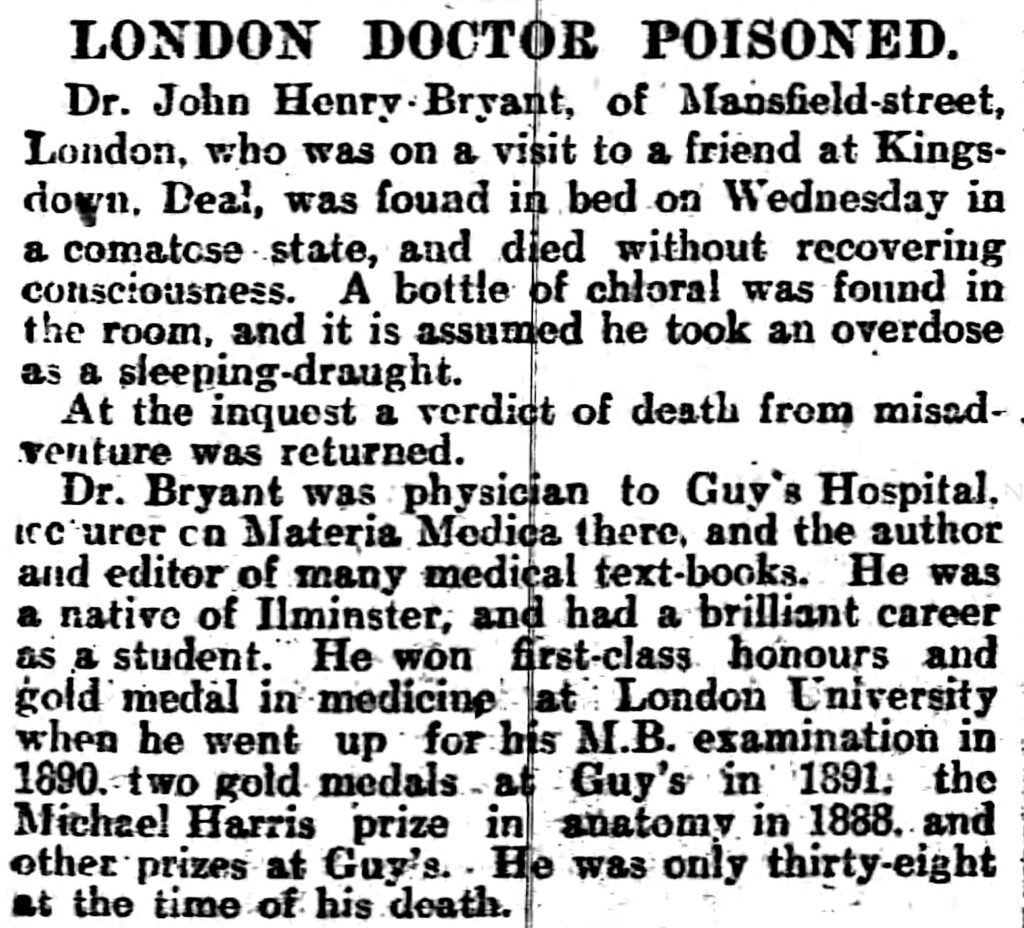John Henry Bryant
John Henry Bryant (1867-1906) was an English physician.
English physician, educator, and diagnostician best remembered for the Blue Scrotum Sign of Bryant, an important early clinical clue in the diagnosis of ruptured abdominal aortic aneurysm. A prodigious talent at Guy’s Hospital, Bryant combined clinical brilliance with a magnetic presence in the lecture theatre and a deep commitment to bedside teaching.
Born June 4, 1867 in Ilminster, Somerset, Bryant was the eldest son of William Mead Bryant. He was educated at Ilminster Grammar School and Sherborne School, later entering Guy’s Hospital Medical School in 1886. His academic performance was stellar: he won the Beaney Prize and both Treasurer’s Gold Medals in Medicine and Surgery (1891), the same year he earned his M.D. from the University of London. He qualified MRCS and LRCP in 1890, and was elected FRCP in 1901.
Alongside a growing consulting practice, he edited Guy’s Hospital Reports and published extensively on abdominal pathology, hyperpyrexia, vascular calcification, and functional murmurs.
Highly regarded for both intellect and integrity, Bryant was also an accomplished athlete representing Guy’s, Surrey County, and Richmond as a rugby half-back and earning praise as a sprinter. Yet his intense professional dedication took a toll. Suffering from exhaustion and illness, Bryant died suddenly on 31 May 1906 in Walmer, Kent. Inquest findings later attributed his death to misadventure via accidental overdose—possibly a reflection of self-treatment during recovery. He was 38 years old.
Bryant was a painstaking teacher and a man of strong personality, as well as a rugby player of county standard and a fast sprinter. Bryant lost his life to a sudden illness in 1906 at the age of 38. He is best remembered for his eponymous sign: The Blue Scrotum Sign of Bryant
Biographical Timeline
- 1867 – Born June 4 in Ilminster, Somerset, England, eldest son of William Mead Bryant.
- Educated at Ilminster Grammar School and Sherborne School, Dorset.
- 1886 – Entered Guy’s Hospital Medical School.
- 1890 – Qualified MRCS and LRCP; graduated M.B., B.S. Lond. with first-class honours in medicine and forensic medicine.
- 1891 – Awarded Beaney Prize and Treasurer’s Gold Medals for Medicine and Surgery; awarded M.D. Lond.
- Rugby: half-back, playing for Guy’s, Surrey County, and Richmond.
- 1892-1898 Medical Registrar at Guy’s Hospital and demonstrator in pathological anatomy
- 1898 – Assistant physician, Guy’s Hospital
- 1899 – Demonstrator in Morbid Anatomy.
- 1900 – Married Stella Beatrice Fry; had one son and two daughters.
- 1901 – Publisher of ‘Guy’s Hospital Reports‘; Elected Fellow of the Royal College of Physicians (FRCP)
- 1903 – Appointed Lecturer on Materia Medica and Therapeutics.
- Died May 21, 1906 at Deal, Kent, aged 38 from overdose of chloral hydrate deemed death by misadventure.
Medical Eponyms
Blue Scrotum Sign of Bryant (1903)
Scrotal ecchymosis associated with ruptured abdominal aortic aneurysm (AAA). Extravasation of blood in the retroperitoneum may lead to nontraumatic discoloration beneath intact penile or scrotal epithelium. Ecchymosis typically appears within 3 to 6 days after AAA rupture.
In these two articles Bryant correctly describes the diffuse nature of the atheromatous changes, the possible clinical presentation of AAA as apparent renal colic, and the scrotal and abdominal discolourations as diagnostic clues.
In one case blood was effused into the right spermatic cord, and the corresponding half of the scrotum was much ecchymosed…When blood is extravasated into the anterior abdominal wall ecchymoses may appear…‘
Bryant JH. Clin Jour. 1903;23:79
Most recorded cases of Bryant’s sign occur three to six days after onset of abdominal symptoms as noted by Pearlman (1940), Barratt-Boyes (1957) and Beebe (1958)
1987 – RM Ratzan et al, identified the correct historical attribution of lower abdominal/scrotal discolouration secondary to aortic aneurysmal disease as belonging to John Henry Bryant.
Major Publications
- Bryant JH. Suppurative pylephlebitis. 1898
- Bryant JH. A Case of Typhoid Fever without any Lesion of the Intestine, which Gave the Widal Reaction During Life, and from which the Bacillus Typhi Abdominalis was Obtained by Culture from the Enlarged Mesenteric Glands Found at the Necropsy. Br Med J. 1899;1(1996):776-80
- Bryant JH. Functional pulmonary incompetence, and dilatation and atheroma of the pulmonary arteries, as complications of mitral stenosis. 1899
- Bryant JH. Acute intestinal obstruction caused by the ileum becoming adherent to a lithopedion. 1899
- Bryant JH. Spleno medullary leuchaemia. 1900
- Bryant JH. Ascites. 1900
- Bryant JH. Haemoptysis. 1900
- Bryant JH. Pneumococcus peritonitis. 1901
- Bryant JH. On lymphadenoma. 1901
- Bryant JH. A case of pneumococcal peritonitis. 1901
- Bryant JH. Two clinical lectures on aneurysm of the abdominal aorta: lecture 1. Clin Jour. 1903;23:71-80
- Bryant JH. The value of blood examinations as an aid to diagnosis and prognosis. 1903
References
Biography
- Obituary: John Henry Bryant. Lancet 1906; 167(4318): 1575
- Obituary: John Henry Bryant, M.D.Lond., F.R.C.P. Br Med J 1906; 1: 1319.
- John Henry Bryant. Guy’s Hospital gazette. 1906; 20: 220-221
- London Doctor Poisoned. The Ormskirk Advertiser. Thu, 31 May 1906 Page 11
- Powell RD. John Henry Bryant, M.D. Presidential address to the Royal College of Physicians 1906: 11
- Biography: John Henry Bryant. Munk’s Roll: Volume IV.

Eponymous terms
- Ratzan RM, Donaldson MC, Foster JH, Walzak MP. The blue scrotum sign of Bryant: a diagnostic clue to ruptured abdominal aortic aneurysm. J Emerg Med. 1987; 5(4): 323-329
- Cadogan M. Atraumatic Abdominal Ecchymosis. LITFL 2020
- Davis AL, Shepherd T, Cadogan M, Foo J. Bryant’s sign as a manifestation of a retroperitoneal paraduodenal bleed and subsequent small bowel obstruction. BMJ Case Rep 2022;15:e247442.
Eponym
the person behind the name
BA MA (Oxon) MBChB (Edin) FACEM FFSEM. Emergency physician, Sir Charles Gairdner Hospital. Passion for rugby; medical history; medical education; and asynchronous learning #FOAMed evangelist. Co-founder and CTO of Life in the Fast lane | On Call: Principles and Protocol 4e| Eponyms | Books |
